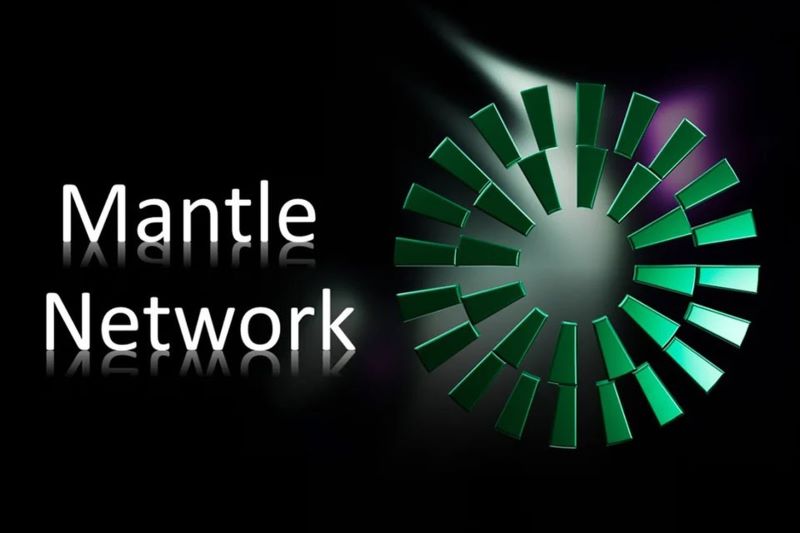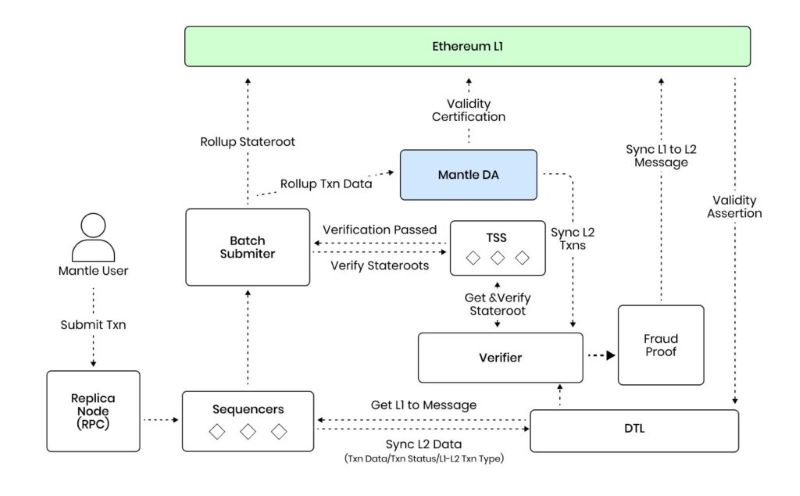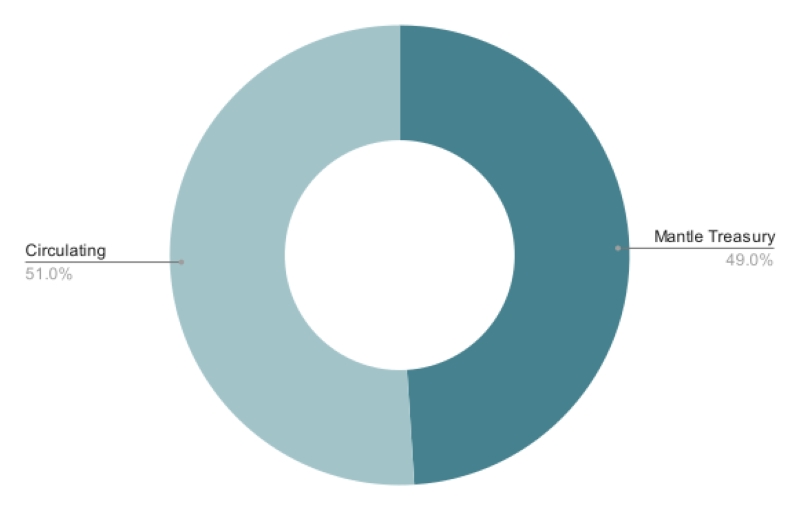Mantle is the predecessor of BitDAO, the largest decentralized autonomous organization (DAO) on the market, backed by the Bybit exchange. Mantle not only carries forward BitDAO’s ecosystem but also builds on it with its own Layer 2 network, known as Mantle Network, serving as the infrastructure for decentralized applications (dApps) within the Ethereum ecosystem.
What Makes Mantle Network Unique?
Mantle Network is a Layer 2 solution built on Ethereum, utilizing Optimistic Rollup technology to enhance scalability and security while reducing transaction costs. Thanks to its modular architecture, Mantle is designed to work seamlessly within the Ethereum network while offering key innovations.
Mantle’s Validators collect transactions from users and commit them to Ethereum as compressed “bundled blocks,” making the system more efficient and cost-effective. By using EigenDA for data availability through EigenLayer, Mantle significantly reduces service fees for users.
Key Problems Solved by Mantle’s Modular Design
Mantle addresses several critical issues faced by existing Layer 2 solutions:
- High Transaction Fees: Traditional Layer 2 users incur high costs as Optimistic Rollups post transaction data on Ethereum.
- Throughput Limitation: Using Ethereum for data availability reduces the scalability of Layer 2 nodes.
- Withdrawal Delays: Optimistic Rollups usually require a lengthy challenge period, often up to 7 days, before users can withdraw assets back to Layer 1.
Mantle’s unique Data Availability (DA) Layer allows node operators to stake MNT tokens to ensure data integrity and availability, while still leveraging Ethereum’s robust security model. This not only enhances staking utility for MNT but also strengthens governance and network security.
Liquid Staking and Beyond
Besides typical Layer 2 services, Mantle introduces Liquid Staking Derivatives (LSD). This enables Mantle users and the Mantle treasury to stake ETH on the Ethereum network while receiving mntETH in return, which can be used within the Mantle ecosystem. Through this mechanism, stakers can earn profits from activities such as MEV (Maximal Extractable Value) and network fees.
Mantle Network’s Architecture
Mantle Network operates on a modular blockchain design. During its initial Mainnet phase, it functions as a Smart Contract Rollup with modular data availability.
- The execution layer offers a EVM-compatible environment, where transaction sequences are processed on Layer 2, while the underlying state data is committed to Layer 1 Ethereum.
- Consensus and settlement occur on Ethereum Layer 1, maintaining Ethereum’s high security standards.
- Mantle’s Data Availability (DA) Layer is powered by EigenDA in collaboration with EigenLayer, ensuring efficient and cost-effective data storage on Layer 2.
The Four Core Components of Mantle DA
- Operators: These service providers verify and sign data, ensuring data availability while staking assets to guarantee their participation.
- Dispersers: These users encode data into blocks, manage funds, and distribute data to operators.
- Challengers: Responsible for verifying the integrity of the network through the Proof of Custody protocol, they challenge any irregular activities.
- Smart Contracts: These contracts run on Ethereum, ensuring that only valid data is accepted and managing the Proof of Custody mechanism.
Transaction Flow and Key Participants
The Mantle network operates with the following transaction flow:
- Users submit signed transactions to an RPC node.
- The Sequencer packages these transactions into blocks, synchronizing data with the Data Transport Layer (DTL).
- Rollup data is sent to a Submitter, which forwards it to TSS Nodes for verification.
- Verified state data is published to Ethereum Layer 1 via the State Commitment Chain (SCC) contract.
- The data is stored on Mantle’s Data Availability (DA) Network for future verification and fraud-proof challenges.
Mantle’s Core Participants:
- Sequencers: Responsible for processing and organizing transactions.
- TSS Nodes: Sign off on transaction batches and state roots.
- Rollup Verifiers: Ensure data integrity and initiate fraud challenges if necessary.
- DA Nodes: Handle data storage and verify its validity through BLS Signatures on Ethereum.
Mantle Network’s Highlights
- Secured by Ethereum: Layer 2 state transitions are validated by Ethereum’s validators, ensuring top-tier security.
- Developer-Friendly Infrastructure: Mantle supports tools like Truffle, Hardhat, and Solidity, providing developers with a familiar environment.
- Reduced Gas Fees: Mantle’s modular data availability architecture lowers gas fees by over 80%.
- Improved Latency and Throughput: Mantle offers customizable transaction confirmation times, with lower latency and higher throughput (up to 500 TPS).
Roadmap and Future Developments
On May 19, 2024, BitDAO announced its official merger with Mantle. This union integrates BitDAO’s governance with Mantle’s technical capabilities, with the goal of building a unified digital ecosystem. As part of this merger, BitDAO’s BIT token was renamed MNT, and Mantle Network gained access to significant financial reserves, including $300M in stablecoins and over 270,000 ETH.
Tokenomics
- Token Name: Mantle Network
- Symbol: MNT
- Blockchain: Ethereum (ERC-20)
- Total Supply: 6.2 billion MNT
- Use Cases: Governance, transaction fees, and collateral for network operators.
Mantle Network is a modular Layer 2 solution with Optimistic Rollup technology that provides enhanced scalability, security, and cost-efficiency for the Ethereum ecosystem. While it brings new innovations, the future of Layer 2 solutions is rapidly evolving, with interconnected networks like Superchain and Hyperchain gaining traction. How Mantle adapts to this trend will be crucial in the coming years.


